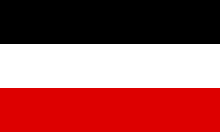Reich flag law
| Basic data | |
|---|---|
| Title: | Reich flag law |
| Type: | Constitutional law |
| Scope: | German Empire |
| Legal matter: | Flag and coat of arms law |
| Issued on: | September 15, 1935 |
| Entry into force on: | September 17, 1935 |
| Expiry: | September 20, 1945 |
| Please note the note on the applicable legal version. | |
The Reichsflaggengesetz of September 15, 1935 (RGBl. I p. 1145) was one of the three laws that the Reichstag passed at the Nuremberg “ Reich Party Rally of Freedom”. At the time it was not subsumed under the Nuremberg Laws ; Under this collective term, the National Socialists understood the anti-Semitic Reich Citizenship Law and the racist “ Blood Protection Law ”. The latter also prohibited Jews from displaying the swastika flag .
history
Shortly after the NSDAP came to power in 1933, the black, red and gold flags of the democratic Weimar Republic were replaced by the old imperial colors of black, white and red . The regulations for this were issued by Reich President Paul von Hindenburg .
In addition to the black-white-red flag, the Nazi party swastika flag should be used if possible.
The reason for the introduction of the Reichsflaggengesetz was an incident in New York in which dock workers on the Bremen tore down the swastika flag . They went unpunished because it was not a national flag. Joseph Goebbels wrote in his diary on September 9, 1935:
“Judge Broudski insults the German national flag. I rush the press on. [...] Our answer: The Reichstag meets in Nuremberg and declares the swastika flag to be the sole national flag. "
With the Reichsflaggengesetz of September 15, 1935, the swastika flag was established as the only valid Reich and national flag as well as the trade flag . With a decree of March 16, 1936, the reintroduction of troop flags was ordered.
The Reich Flag Act was repealed by the Control Council Act No. 1 on the repeal of Nazi law of September 20, 1945.
Flagging
The raising of house flags on national holidays or other occasions was not compulsory. If this was not done, however, it was considered an act of demonstrative refusal. The block attendant noted this in his house file. There was also a form letter as a warning in which only the name and date had to be entered.
Examples of resistance actions
Many clergymen came into conflict with the state authorities for the first time when they deliberately violated the Reich Flag Act. The imperial or national flag should be hoisted on state or church holidays. The aim was to restrict the churches' ability to represent themselves externally.
Pastor Karl Zaschka from Hochstadt , Lichtenfels district , is known as an example of many Catholic priests :
Karl Zaschka “had, according to the May monthly report of the District President [of Middle Franconia ] Hans Dippold, that the Archbishop ( Johann Jakob von Hauck ) , who came from Bamberg on May 8, 1941, had about 80 children up to 10 years old with white and blue , white and yellow flags and swastika flags. The pastor was charged and his permission to give religious instruction in elementary schools was subsequently withdrawn. "
Individual evidence
- ↑ Meyers Lexikon , 8th edition, eighth volume, Sp. 525, Leipzig 1940: " Nürnberger Gesetz, Bez. For two significant laws of the nat.-soc. Reichs: Blood Protection Act and Reich Citizenship Act. "
- ^ Peter Longerich: Politics of Destruction ... , Munich 1998, ISBN 3-492-03755-0 , p. 622.
- ↑ Cornelia Schmitz-Berning: Vocabulary of National Socialism. Berlin 1998, ISBN 3-11-013379-2 , p. 297.
- ↑ Siegfried Kögler: Examples of the resistance of Catholic clergy in Bavaria against National Socialism ( page no longer available , search in web archives ) Info: The link was automatically marked as defective. Please check the link according to the instructions and then remove this notice. , Working papers of the Willy Aron Society Bamberg eV, issue 4/2008, p. 10.


